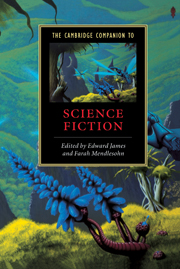9 - Postmodernism and science fiction
from Part 2 - Critical approaches
Published online by Cambridge University Press: 28 May 2006
Summary
Given that sf is notoriously difficult to define, and that postmodernism is (usually) resistant to any absolute definition, any account of postmodernism and sf risks collapsing under the weight of its own hesitations. This chapter will isolate several theories of postmodernism, examine the interplay of postmodernism and sf and offer a brief critique of postmodernism. It should perhaps be taken for granted that much postmodernism reads like sf.
Definitions
Postmodernism came into critical focus as an approach thanks to an article by Fredric Jameson, and soon became one of the commonest critical approaches to sf. The term pre-dates Jameson; most significantly in architecture ‘postmodernism’ had been used to designate a particular style which rejected the brutalism of modernism in favour of eclecticism, quoting from earlier styles and mixing aesthetics.
In the 1960s and 1970s ‘postmodern’ began to be applied to a series of writers active after 1945 whose works demonstrate knowledge of their own fictionality, either by drawing attention to the creative process of narration, by containing books within books or by breaking down boundaries between author and characters – examples include the works of Beckett, Burroughs and Borges. Kurt Vonnegut is perhaps the author who has most featured himself as a character within his own science fictions – partly in the debate about sf in the novels featuring Kilgore Trout, but most clearly in his interventions into such narratives as Slaughterhouse-5 (1969), drawing on his experience in Dresden after the Allied bombing raid, or Breakfast of Champions (1973), especially at the end when he sets his characters free. It should be emphasized that Vonnegut here is just another character, just as Tom Robbins is when doing battle with his typewriter in Still Life With Woodpecker (1980) and Robert Sheckley when he tries to get his narrative to work in Options (1975).
- Type
- Chapter
- Information
- The Cambridge Companion to Science Fiction , pp. 137 - 148Publisher: Cambridge University PressPrint publication year: 2003
- 4
- Cited by



